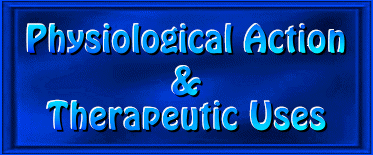

The following is excerpted from The Professional's Herbal Formula Handbook No. 2, comprising 82 pages of traditional information and recent scientific data that describes the medical properties, physiological action and therapeutic uses for each of the 24 ingredients outlined in this formula.




Adaptogenic, alterative, anabolic, antibiotic, anti-cachexic, anti-dyscratic, anti-infective, antineoplastic (anti-tumor), antioxidant, antiphlogistic (anti-inflammatory), antiseptic, bacteriostatic (anti-bacterial), chloretic, cytophylactic, cytotoxic, decongestant, disinfectant, diuretic, fungistatic (anti-fungal), immuno-potentiating, immuno-stimulant, microbicidal (anti-microbial), rejuvenative, stimulant (circulatory and secretolytic), tonic, tropho-restorative, vasoconstrictor, vasodilator, vasotonic and viricidal (anti-viral).


Alleviates any general fluids dyscrasia (abnormal or pathological condition) within the blood vessels, tissue-systems and mucous membranes throughout the entire organism during the onset of any immuno-depressant or immuno-suppressant conditions, and eliminates any form of cachexia (state of malnourishment and general debility) within the blood vessels, tissue-systems or mucous membranes throughout the entire organism in order to provide increased protection against any nutritional deficiencies or insufficiency that leads to various forms of immuno-depression or immuno-suppression; displays immuno-stimulatory effects, especially against any infectious conditions in the linings of the mucous membrane of the oral cavity, throat, sinuses, bronchi, urogenital organs and gastro-intestinal tract; exhibits immuno-potentiating and immuno-stimulatory effects in order to enhance greater long-term immune potential and overall non-specific systemic immunity (or immune cell activity) and increased immune response (by activating the body's natural defense mechanisms), particularly in relation to the repair and restoration of any damaged or congested blood vessels, tissue-systems or mucous membranes throughout the entire organism; displays cytotoxic and cytophylactic properties in order to provide stronger cellular defense mechanisms against many physical or chemical agents and infectious conditions, including various brain, skin or intestinal infections; demonstrates bacteriostatic, microbicidal and viricidal activity in order to strengthen and increase the resistance of the blood vessels against any invasive or harmful pathogenic bacteria or microbes, as well as to inhibit the further development of any inflammatory or infectious conditions that lead to the onset of various auto-immune disorders; possesses a high content of biologically active alkaloids (berberine, hydrastine, and canadine) that act as broad-spectrum antibiotic, anti-microbial, anti-protozoal and fungistatic (anti-fungal) agents against a wide range of harmful microorganisms, including Staphylococcus spp., Streptococcus spp., Chlamydia spp., Corynebacterium diphtheria, Salmonella typhi, Vibrio cholerae, Diplococcus pneumonia, Candida albicans, Treponema pallidum, Leishmonia donovani, Giardia lamblia, Escherichia coli, Pseudomonas spp., Shigella dysenteriae, Entamoeba histolytica, Trichomonas vaginalis, Neisseria gonorrheae and N. meningitidis; interferes with any infectious conditions that are caused by group A streptococci (due to the activity of berberine) by inhibiting streptococcal growth and blocking the adherence of these organisms to host cells by allowing this form of bacteria to release lipoteichoic acid (LTA), which is the substance that is primarily responsible for the adhesion of this bacteria to host tissues; prevents the adhesion of fibronectin to the group A streptococci (due to the activity of berberine), as well as eluting (washing out) any fibronectin that is already bound; prevents the overgrowth of yeast (a common side-effect from the frequent usage of synthetic antibiotics), due to the presence of berberine; destroys any yeast, fungi or harmful pathogenic microbes throughout the gastro-intestinal tract, and removes any cervical erosions or light papillary vegetations; displays significant antiphlogistic activity in order to inhibit the formation of certain inflammatory compounds (such as histamine, leukotrienes, prostaglandin, serine proteases and thromboxanes), as well as to reduce any severe inflammatory swelling associated with any blood vessel or tissue inflammation and various other internal inflammatory conditions; accelerates the healing process during various inflammatory or infectious conditions, while reducing any fevers or feverish states; soothes the mucous membrane linings of the digestive, respiratory and genito-urinary tracts during any infective, congestive or inflammatory conditions that are induced by allergies or infections, and displays tropho-restorative effects upon any irritated, inflamed or ulcerated mucous membranes in those conditions involving conjunctivitis, keratitis, enteritis, cholecystitis, cervicitis, pharyngitis, tonsilitis, urethritis, vaginitis, and orifice soreness or discharge; exhibits significant antiseptic activity by destroying the vitality of any organized living ferments in order to prevent the onset of putrefaction or septicemia, and precipitates the proteins in any inflamed tissues in order to provide a mildly antiseptic and protective coating (under which the regeneration of new tissue occurs) for the mucous membranes throughout the entire organism; acts as an effective antiseptic in order to remove any septic conditions associated with tissue degeneration or ulceration, and promotes increased suppuration and a steady toning or restorative impression to the entire glandular system (especially the liver and lymph glands); displays antineoplastic activity in order to inhibit the formation of tumors, due to the presence of berberine; displays profound immuno-stimulatory effects by increasing the blood supply to the spleen (due to the action of berberine), thereby promoting optimal activity of the splenic function and the subsequent production and release of many immuno-potentiating compounds in the form of small molecular weight peptides (such as tuftsin); acts as a potent activator for increased macrophage activity for the purpose of engulfing and destroying any harmful pathogenic or mold-like bacteria, viruses, yeasts, fungi, parasites, tumor cells, and various other invasive microbes or infective organisms, due to the presence of berberine; strengthens the entire immune system, while stimulating and enhancing the body's own defense mechanisms in order to ward off disease; stimulates optimal thymus gland activity, prevents thymic involution or shrinkage, and insures proper thymic hormone levels; removes any catarrhal conditions in the mucous membranes (accompanied by profuse secretions of thick viscous yellow or yellow-green muco-purulent discharges), especially in those conditions involving acute respiratory infections (such as influenza, colds or sinusitis) and duodenal catarrh; eliminates various forms of pharyngitis (simple, catarrhal, follicular and granular), as well as any subacute naso- or retro-pharyngeal catarrh; exhibits anabolic activity in order to accelerate the production of DNA and RNA (which enhances the production of proteins in the form of antibodies), while increasing protein and lipid synthesis in the bone marrow and DNA/RNA content in the adrenals and lymph nodes (along with increased body weight and enhanced re-synthesis of glycogen and high-energy phosphate compounds); demonstrates powerful adaptogenic (balancing and strengthening) activity in order to increase the overall resistance of an organism towards any adverse influences or stressful conditions (whether they be physical, chemical or biological in nature), especially upon the immune system and both the central (cerebro-spinal centers) and peripheral nervous systems; acts as a secretolytic stimulant in order to promote increased gastric, pancreatic or intestinal secretory and motor activity, and enhances greater peripheral circulation (due to its antioxidant activity); exhibits significant antioxidant effects in order to provide greater oxygen-transport capabilities throughout the bloodstream, as well as enhance the transport of additional oxygen directly into the cells and tissue-systems throughout the entire organism; acts as a circulatory stimulant by increasing the blood flows through the arteries and blood vessels in order to enhance greater nutrient transport, absorption and utilization, thereby accelerating the healing processes associated with the repair of any damaged mucous membranes or tissue-systems; demonstrates significant rejuvenative and restorative properties upon the basic plasma tissue-systems throughout the entire organism, thereby enhancing the production of vital bodily fluids while providing greater enrichment through increased assimilation of the various organic mineral salts; accelerates the recuperative processes that are essential in order to overcome any chronic debilitating or degenerative brain diseases or illnesses, while facilitating greater recovery response during convalescence in order to regain optimal health and well-being; displays alterative activity in order to correct any disordered bodily function, thereby activating increased alterations in both metabolic and tissue functions as a defensive measure against the onset of acute or chronic disease; exhibits restorative effects in order to regain increased vigor or vitality and greater strength, while enhancing normal tissue and metabolic functional capabilities; demonstrates alterative and restorative properties in order to re-establish healthy systemic functional capabilities, as well as to establish greater vascular tone throughout the entire organism (due to its ability to stimulate increased secretory flows); exhibits alterative effects in order to stimulate the anabolic growth processes, thereby enhancing the repair of any degenerated, deteriorated or debilitated cells or tissues (while promoting the elimination of any catabolic waste materials); displays tonifying effects in order to permanently enhance the overall energy-levels throughout the entire organism, without adversely affecting the functional capabilities of any particular organ or system.
![]()
None.
![]()